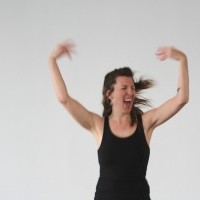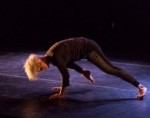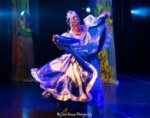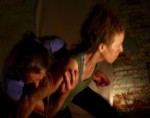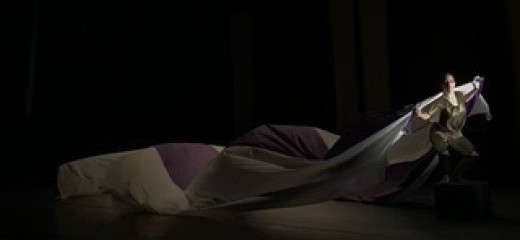
Site, Skin and Self: A Week with Rosy Simas
by Janna Meiring
“Where do you come from?” This past season, Intercultural Journeys invited artists, with many divergent and intersecting perspectives, to “tease out nuanced definitions of identity and belonging.” Rosy Simas was one of these artists, presenting her current dance project, Weave, in Philadelphia this past March.
The week was comprised of several parts: a ListenIN* event at the Pearlstein Gallery, where Simas performed solo and had a post-show dialogue; a movement workshop with Sam Mitchell (a member of her company); and the final presentation of Weave, which included four Philadelphia dance artists. I also attended an open rehearsal and interviewed Simas and Mitchell to learn about the process and reach of her work.
Weave brings together Simas’s film, visual installation, sound collaborations, and choreography—culled from movement practices she calls “deep listening” and “skin activation.” In addition to teaching these practices to local dance artists wherever her work is presented, Simas and her company build a framework for engagement, education, and outreach, putting advocacy for Indigenous issues first and re-centering Native narratives in contemporary performance.**
In her solo at ListenIN, Simas moves as if the air around her is tangible. She slowly draws her curved arm along the side of her body as she steps into the light. Two projectors illuminate the adjoining walls with a film of shallow waves over sand. The film loops and overlaps, doubling against itself, creating an amplified impression of waves on the landscape of her body. The sound score, composed by François Richomme, encompasses the room with echoes of an old clock ticking and periods of static at a volume just past comfort. As she moves, my mind resonates with colliding histories of the land we are on: those seen and those made invisible. Simas’ answer to the question “Where do you come from?” begins with moving while listening.
Afterwards, she and Ahimsa Timoteo Bodhrán, who does outreach for Simas, chat about her Haudenosaunee (Seneca) identity and her evolving artistic process. They share images of previous works including We Wait in Darkness (2014), a solo invoking her grandmother’s experience in forced settler-colonial schooling, and Skin(s) (2016), a collaborative multi-media project that collages footage of contemporary Native people speaking about how they view themselves in the world.
For Simas, the creative process is both cyclical and generative. Elements of one work trail into the next or are threaded back in with different mediums. Continual movement, loud vibrating sound, or light activates the perception of the skin and opens the perception of emotion. This generates new connection, new meaning, and subsequently, new material.
“I created a duet called Bonding and Defending (circa 2005),” she tells me during our interview, “which was about war, but really looked into the defense mechanisms of the body. So, I think that [my focus on] sense perception of skin and touch, which is related to listening, started then.” From that point, these ideas reappeared through her work, organically developing into repeatable scores that investigate aspects of self, identity, and history. “For me, in my practice, I feel directly and deeply connected to my family and place. Those things, through listening, are always with me and always available to me.”
While creative investigations of identity and history through “skin activation” could be applied to people of any cultural background, Simas offers this work for Native People and People of Color specifically. Re-centering Native and POC voices in contemporary performance—which is still dominated by Eurocentric values and stories—is essential for reforming our view of who we are and where we come from. My interview with Mitchell touched on the impact of this work in his personal experience of identity. A Yaqui Indian, Mitchell was adopted by a white couple and raised without contact with Native culture. He shared that working with Simas has supported an active remembering of his own indigeneity, and has subsequently dis-entangled aspects of white culture that have been ingrained into his body and mind. The double-sided nature of his experience, he explains, requires effort to unpack but, beyond this initial struggle, lives a more integrated self that he has longed for.
Because of the potential vulnerability of the practices, Simas strives to maintain balance between giving direction and offering guidance. “[The local artists] are diving into a process which is unknown to them…. I don’t ask people to do things that are physically, spiritually or emotionally not where they are willing to work themselves.” Beyond creating a safe environment for the artists, making Weave requires Simas to be fluid in her role, adapt to changes quickly, and hold the mantle of good leadership. When navigating a field that has specific historical hierarchies in place, she says, “there is a balance between … being a leader and staying in charge … and facilitating people to have their own voice.”
For the Philadelphia version of Weave, four local dancers, Kimya Imani Jackson, Jung Woong Kim, Mehgan Abdel-Moneim and Aya Razzaz attend two four-hour rehearsals at the Performance Garage. They first learn the foundations of “skin activation,” “deep listening,” and set choreography, and then Simas weaves all the pieces together to create the format for the performance. During the second rehearsal, I witness the two Rosy Simas Danse company dancers—Zoë Klein and Mitchell—work one-on-one with the Philadelphia artists. Klein demonstrates a subtle shift of movement through the top of her head down her spine. “I am allowing the light to enter me and track down through the tailbone,” she says to Razzaz. Farther upstage, Mitchell guides Abdel-Moneim through a long score of “skin activation.” Meanwhile, Simas swiftly moves among directing dancers, changing the projection angle, standing in as herself onstage, and back up to the audience seating to speak to her creative team. I witness how she quickly translates, adapts, and infuses the creative components into a new environment.
“My work is really based in an aesthetic of listening … it is really the underpinning of the whole thing.” Rather than placing a complete work at different locations, as many touring companies do, Simas allows the necessary time to integrate the concepts of “deep listening” and “skin activation” with getting to know the place itself. She visits the location at least once before each residency and conducts thorough research. This informs the building process that is required to take material that already exists—choreography, improvisational scores, segments of film and sound—and reweave them together anew. In this way, Weave is not a capsule experience; it shifts depending on the community Simas and dancers are in and requires an enormous amount of collaboration leading up to the residency.
So far, Weave has been presented in St. Paul, Minnesota, and at the Poarch Creek Band of Indians reservation in Alabama. These projects were either highly supported by or presented within Native communities. For urban projects, as in Philadelphia, Simas and her team work hard to get the word out to local Native communities and must also develop opportunities for communicating a large (and largely-ignored) history to a non-native audience.
When contemporary dance culture continues to prioritize Eurocentric aesthetics and values, Mitchell points out, it perpetuates the erasure and invisiblization of Native people and People of Color. Simas situates her projects and events as an antidote to this. They will be presenting Weave again in Washington, D.C., in the spring of 2020. I recommend a road trip.
*ListenIn was presented in partnership with the Leeway Foundation with support from the Pearlstein Gallery.
**Simas co-edited a special issue of Dance Research Journal titled Indigenous Dance Today, and an article on her recent protest against American Realness festival artist Latifa Laâbissi.
ListenIn, Leonard Pearlstein Gallery, March 5; Weave, Rosy Simas Danse, Performance Garage, March 8-9
By Janna Meiring
June 6, 2019

